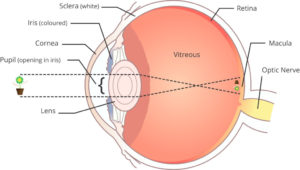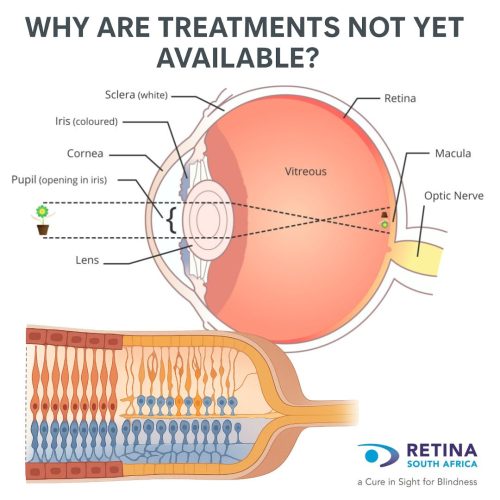WHY ARE TREATEMENTS NOT YET AVAILABLE
To understand why, we need to understand the complex structure of the retina and the intricate biological processes that converts photons of light to a detailed visual image in the brain.
The retina is one of the most metabolically active cells in the body, requiring huge amounts on nutrients and oxygen. This fragile, multi-layered, complex retinal structure needs perfect conditions to function and mutations, mistakes, in the genes [see more below] cause malfunction, accumulation of waste products, and cell death.
Light enters the eye through the cornea, the transparent layer at the front of the eye, where the focusing process begins. It then travels through the pupil and reaches the lens, which further sharpens the light and directs it onto the retina.
Inside the eye, the vitreous, a clear, gel-like substance, can contain tiny impurities that may interfere with the clarity of the image reaching the retina. Prescription glasses or contact lenses help fine-tune the focus, resulting in sharper vision.

Cross Section of the Eye
Researchers have made great progress in trying to rectify genetic mistakes, clear waste product and renew damaged cells.
Global research to find treatments and cures for retinal vision loss is advancing rapidly. Areas such as stem cells, gene therapy, gene editing, optobionics, artificial retinas, and pharmaceutical interventions are all making steady progress. Many are in advanced clinical trials and registration is expected within a few years. The effect of lifestyle and supplementation on retinal health is also receiving serious attention.

More Articles
Article title: James Cape – Retina SA Chairman 2006-2021 .
James Cape - Retina SA Chairman 2006-2021 It is with great sadness that we bring you the news of the.
Article title: Getting into QR Codes .
QR codes are the square blocks with a strange pattern that are being used more frequently for many online.
Article title: World Sight Day 8 October 2020 .
Retina International launches a United States and Canada cost-of-illness study today, October 8th 2020, as part of World Sight.